1561
Aviation Museum, Kiev
Kiev Museum of Aviation was founded in 2003. The exhibits are placed on the old runway. At the site of 15 hectares samples of civil, transportation, military, and even a naval aviation. Besides aircraft and helicopters, and there is a means of combating air targets. The sources of continuous replenishment of the museum began a series eksponatnogo airfields, which remained written off the board - the historical evidence of development of domestic aviation. These machines were given in the exposure condition effort Ukrainian aviation industry enterprises, and then took his seat on the court at the museum.
My Photo.

1. Symbolic "Yak" in the 70s starred in the movie "go to fight some old" - probably the best and most truthful cinematic about pilots in the war. According to the story, it "flew" the protagonist of the film, the commander of the "Singing Squadron", whose role is performed Leonid Bykov. Perhaps that is why this exhibit is not an exact replica of a specific aircraft: every veteran who has ever fought on the "yak", will find in it the features of "their" machines - the Yak-1, Yak-3 and Yak-9.
Yakovlev fighters were the massive war machines of Soviet aviation during the Great Patriotic War - a total of almost 36,000 built. On the "yak" fought as French pilots of the regiment "Normandie-Niemen" and Polish pilots of the regiment "Warsaw".
Plane restored at the Kyiv Aircraft Repair Plant №410.

2. scout and light bomber "Anatra-Anasal" went down in history as the first production aircraft, which was manufactured in Ukraine. It was created and produced the first of the former Russian Empire specialized aircraft plant in Odessa, which was owned by businessman Arthur Anatra. The device at the time of the classical scheme biplane first flew on July 27, 1916. The crew consisted of two people - a pilot and an observer-arrow armed with machine guns. He also, if necessary, manually removed the bombs on the enemy.
Serial production of "Anatra" began in a stormy 1917, so his fate appeared Determined adventure. Quite a point that he had to make war under the flag ... as many as six states - Russia, the Ukrainian People's Republic, Austria-Hungary, Austria, Czechoslovakia and Hungary. And that's not taking into account the use of the White and Red armies.
In total in 1917-1918. was built over 350 aircraft "Anatra", however, remained only one - in the Czech Republic. The Ukrainian Museum presented a full-scale mock-up created at the Odessa Aircraft Repair Plant.

3. Yak-18PM is a further development of the design created in 1946 training aircraft Yak-18. Option PM (ie "aerobatic modified") first took the air in December 1965, was created exclusively for the athletes - masters of aerobatics of the highest class. The machine had forced the engine and significantly improved aerobatic properties that enabled the Soviet national team in 1966 to win the championship at the IV World Championships in aerobatics. Yak-18PM - it's quite a rare artifact, because all were built only 30 such aircraft. Several of them flew in the Kiev club DOSAAF.

4. The first Soviet short-haul passenger jet Tu-134 has created the most popular "creative method" in Tupolev - the maximum use of units from the previous design.
To do this, all the dimensions of the Tu-104 reduced by 20%. However, the first version of the machine was unsuccessful - the plane appeared inconvenient both for passengers and for staff. Interestingly, to create a more successful model of Tupolev inspired Nikita Khrushchev: during a visit to France, he flew on a plane "Caravel", and placing the engines in the rear he liked - the noise in the cabin is almost not felt.
Serial production of the Tu-134 is also held in Kharkov - in 1966-70 years was built 78 machines. Tu-134 was the first Soviet aircraft certified according to international standards of airworthiness. He still flies on many airlines in Ukraine and CIS.
The museum kept the ship in two models - the third pre-production Tu-134 and Tu-134A serial.

5. Tu-134A.

6. Mid-range aircraft of the second generation of the Tu-154 created in the late 60s. It incorporates the best qualities of the first generation of aircraft: the speed of the Tu-104, the range and efficiency of the IL-18, and the comfort and landing characteristics of the An-10.
Thanks to the good aerodynamics and new engines, these machines for a long time were the most efficient in the "Aeroflot", so it is quite a lively were exported. In the 80 years of the Tu-154 was called "the workhorse of Eastern European airports." More than half of Aeroflot's traffic carried these machines. They were taken on board up to 176 passengers and transported them to a distance of 3900 km. A maximum range (with 164 passengers) reached 5,200 km.
A total of 1969-2000 years was built more than 930 Tu-154.

7. Heavy Duty Mi-26 was created in the late 70s. It is capable of carrying up to 20 tons of cargo at speeds up to 300 km per hour. These powerful machines are armed with only two states - Ukraine and Russia. The museum carries a copy of the white camouflage as a memory on the participation of Ukrainian aviators in peacekeeping operations under the auspices of the UN.

8.Kabina Mi-26 pilots.

9.Gruzovoy compartment of the Mi-26.

10 heavy transport Mi-6 first flew in 1957 and up to the mid-70s was the most powerful helicopter in the world. He was capable of carrying loads of up to 12 tons, or up to 90 people or two landing light self-propelled gun. An interesting design feature of the machine is the presence of the wing, which made it possible not only to take off vertically, and a plane - with a running start.
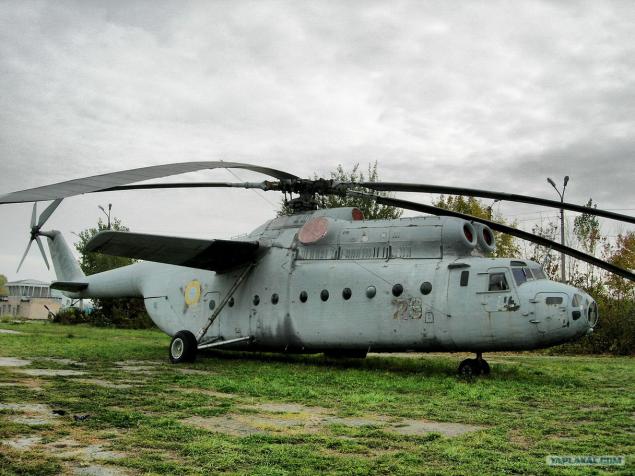
11.Dvigatel sectional.
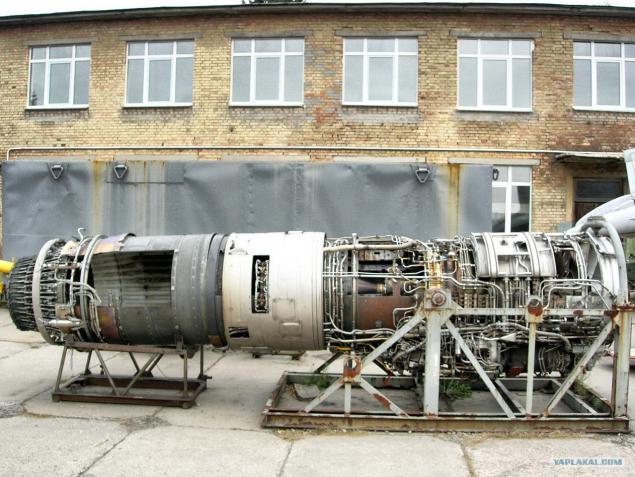
12. Tactical Unmanned spy plane BP-2 "Swift" (Tu-143).

13.Vooruzhenie.

14.Be-6. The museum exhibits a plane (the product of CR), which in 1965-1967. carried out work on the installation of a communication system with the submarine submerged (the theme of "liner"). In 1965 he developed the design of antennas, and January 6 next year, made drawings of equipment installation "Liner". In the summer it has begun installation of equipment in one of the Be-6, but work was suspended in June, so that they continue to re-dedicated aircraft № 4601403. However, the transfer of the machine is significantly delayed, and the installation of the antenna is only held in January-February 1967 the aircraft was passed the test in the 318th OPLAP Force Black Sea Fleet in Donuzlav, but their results were not satisfactory, and the subject was closed.

15. Be-12. Armament: The combat load - 1500 kg (normal) or 3000 kg (maximum) 4 hardpoints and compartment weapons: anti-450mm torpedo AT-1 and AT-2, depth charges GB flares SAR markers.
Series production: 1963-72 years. Total built 142 aircraft.

16. ASW helicopter Mi-14PL. Mi-14 is a "sea" of the same version of the Mi-8. This so-called "amphibious", which can take off and land on conventional airfields land and on the water surface or deck ships. The museum still has two options - anti-Mi-14PL and helicopter Mi-14T minesweeper. The first modification is designed to find and destroy submarines. It is equipped with a special search equipment and weapons - with special anti-submarine torpedoes and depth charges. Specialty of the second variant of the helicopter - the purification of the fairways and the coast from the sea mines of all kinds.

17. Mi-14T.

18. The first Soviet carrier-based helicopter Ka-25 was created in the early 60s. It comes in three versions - antisubmarine, and search and rescue radar (for targeting missile cruisers). Six Ka-25 have been converted into "air sweepers." These machines caused a stir in 1974 during mine clearance of the Suez Canal. The museum is the most common version of the helicopter - ASW Ka-25PL.

19. The Ka-27 is also designed as a first anti nonetheless, he later became a multi-purpose. At least 10 variants are still in production.
Museum instance Ka-27PL has significantly expanded, compared to the Ka-25, the scope for anti-submarine warfare. He is able not only to detect them, but also to destroy torpedoes or depth charges in semi-automatic mode. The helicopter is part of the weapons class frigate ships, including "Hetman Sagaidachnogo" Ukrainian Navy.
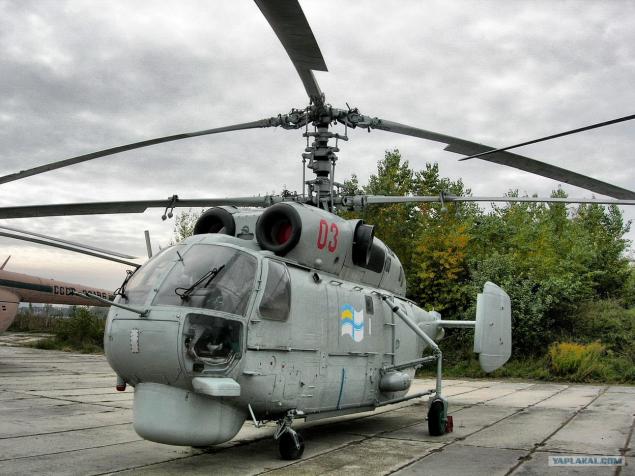
20. Passenger jet airliner Yak-40 was created in the mid-60s for short (regional) airlines, which was to replace the old piston planes. He took on board up to 32 passengers and transported them to a distance of 1,800 km at a cruising speed of 500 kilometers per hour. The absence of Soviet power the engine must be made to establish three constructors engine AI-25. The aircraft has proven reliable in operation, however, is not enough economical. In the years 1968-81 issued in 1180 Yak-40, of which nearly three hundred more airlines fly to 18 countries.

21. The long-range anti-submarine aircraft Tu-142MZ was the biggest not only in the Soviet naval aviation, but in the world: its wingspan - almost 50 meters and the total capacity of the four engines - 60 thousand horsepower! It is designed to find and destroy submarines with nuclear missiles in the vast oceans.
The advent of submarines with nuclear missiles made to develop the means to find and destroy them. The most versatile and mobile of them is the aircraft equipped with a special system for detection and destruction.
The development of the first Soviet long-range anti-submarine complex began in the USSR in the early 60s on the basis of reconnaissance aircraft Tu-95RTS.
Experimental instance first flew on June 18, 1968. In December 1972, the aircraft, which received index Tu-142 was adopted. Serial production started at the aircraft factory in Kuibyshev (now Samara), and since 1975 its production was moved to Taganrog.
The structure consisted of a complex anti-search and sighting system (PPS) "Berkut-95", the search gidroakkusticheskie buoys, which were developed in the Kiev scientific research institute "Gidropribor" and Munitions: anti-submarine torpedoes, depth charges and naval mines.
System "eagle" detect submarines by four channels: gidroakkusticheskim (during turn on depth), magnetic and thermal (at a shallow depth) and Radar (sea surface). However, the sensitivity of its sensors was insufficient, so in 1975, was established modernized version of the Tu-142M s PPP "Kite". Eight of these machines under the symbol TU-142 M-E (export) in 1986 were delivered to the Indian Navy.
The most modern version of the machine is the Tu-142MZ, made its first flight in April 1985. New PPS "district" allowed to raise the combat efficiency of the complex 2-2.5 times. It was adopted in 1993, although production began in 1990. However, for economic reasons, the production stopped in 1994, releasing only 18 machines.
The armament of the Tu-142M and the Ministry of Health also includes anti-missile ACR-2 and ACR-3.
In 2001, the Air Force Northern and Pacific Fleet had a total of 55 aircraft, with two thirds of them were in conservation.
To communicate with submarines on the basis of Tu-142MZ in the early '90s was built aircraft transponder Tu-142MR equipped with long-wave radio.

22. Tu-142MZ.

23. Tu-134UBL. Training aircraft for pilot training range aviation
First flight: January 15, 1981.

Tu-24 long-range supersonic bomber 22M3--bomber / reconnaissance variable geometry wing.

25. Tu-22M3.
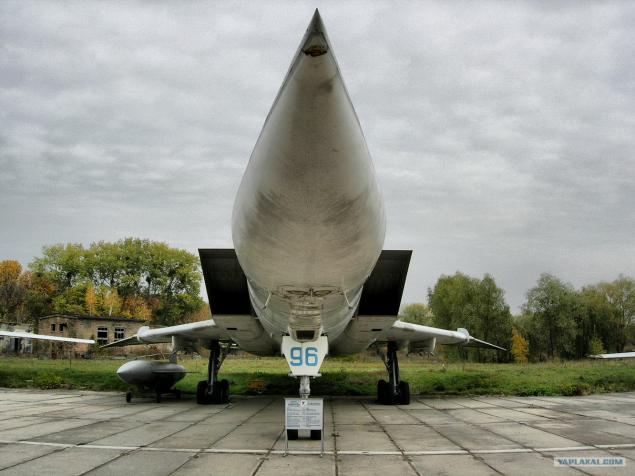
26. During the "Cold War" missile supersonic bomber Tu-22M was intimidating NATO. These machines were "eurostrategic", ie able to launch a missile attack on any object in Europe from a distance, even without going to its zone defenses. NATO they got the code name "Bekfayr".
This powerful plane created in Tupolev Design Bureau in the late '60s, thanks to the wing sweep combined high supersonic speed (reached 1800 kilometers per hour) with a considerable range and the ability to operate with relatively short runways.
The first model - the Tu-22M-0 - was armed with only one cruise missile and was released in 10 copies. The world survived only two Tu-22M-0 - the State Museum of Aviation in Kiev and Russian Museum in Monino.
An improved version of the Tu-22M-2 had been armed with three Kh-22 with a range of 450 km. These missiles could equip oneself usual, protivoradarnyh or nuclear warheads. Presented in the exhibition model rocket X-22H were fitted with nuclear warheads of 200 kilotons capacity (ten times greater than the bomb dropped on Hiroshima). The aircraft can refuel in the air, so had virtually unlimited range. In all there were 500 bombers Tu-22M on all models.
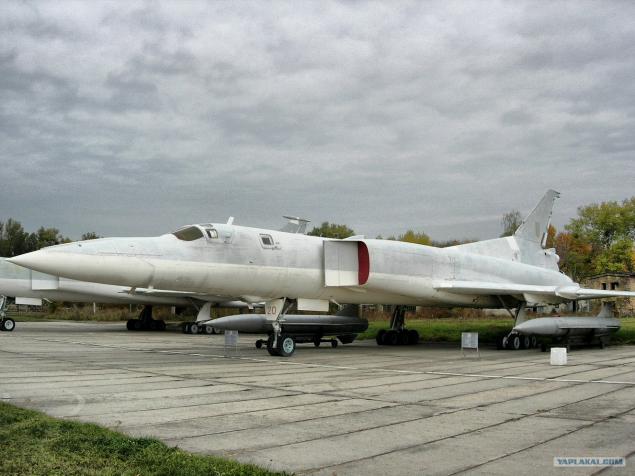
27. The rocket model X-22H.
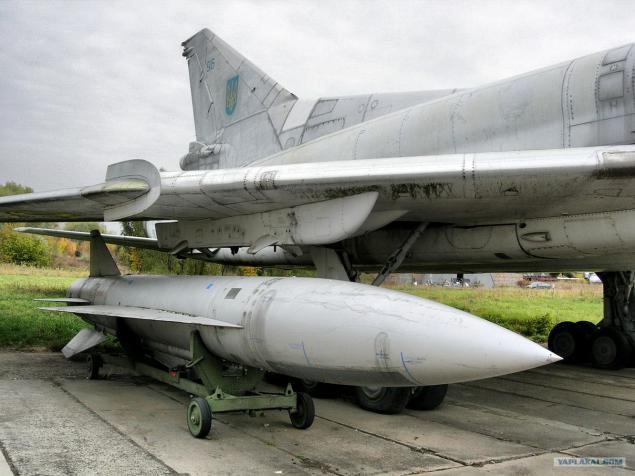
28. Far-bomber Tu-22-M-0.

29. Impact of the Mi-24 - a "flying infantry fighting vehicle." The helicopter is not only powerful weapons and armor, but is able to take aboard up to eight shooters. Marines can fire in flight through the cabin windows. The crew consists of a pilot and a weapons systems operator. Under the wings of eight hardpoints machine is capable of carrying both conventional weapons (bombs and rockets blocks), and precision-guided anti-tank missiles.
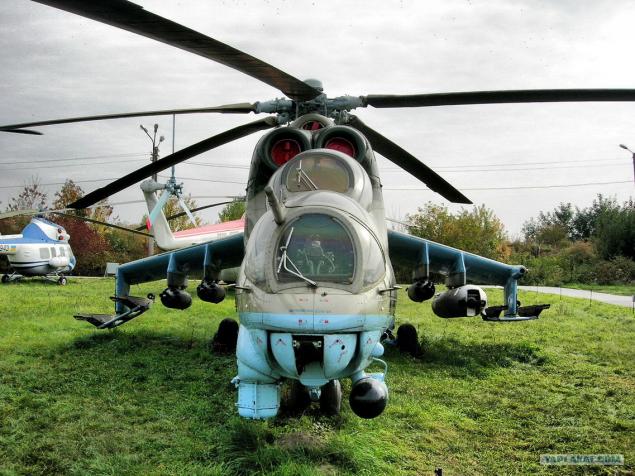
30.Mi-24D.

31. IL-76 is a powerful military-transport aircraft the Air Force of Ukraine. These machines carry our peacekeepers in Iraq, Lebanon, and fly around the world under the flags of the air transport company of the Ministry of Defense. It was her color carries a copy of the museum. IL-76 - a specialized transport plane capable of carrying loads of up to 40 tons (or 145 paratroopers) at a cruising speed of 750-800 kilometers per hour at a distance of up to 7,000 kilometers. For a quick loading or unloading of his cabin is equipped with special equipment - winches, hoists and other equipment. After a wide, three-hatch in the tail of the fuselage can enter 1-2 armored personnel carriers, infantry fighting vehicle and two trucks.

32. IL-76.

33. On the night of 15 on October 16, 2010 brought the future museum exhibit AN-71.

34. Wings of An-71 is separately.
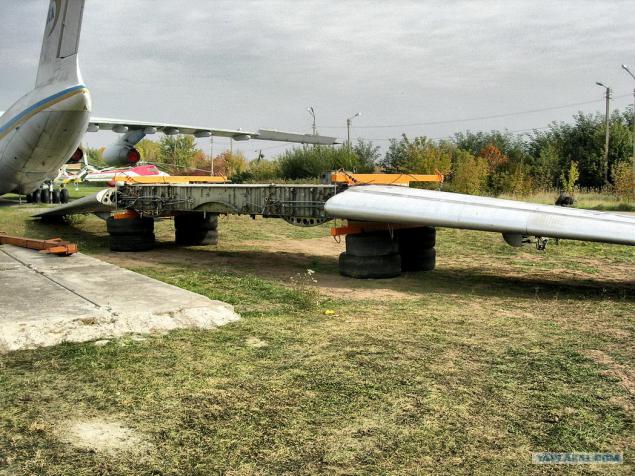
35. An-26 - the most common transport aircraft in the world. It was created in 1968 on the basis of the An-24 was manufactured by the Kiev plant "Aviant." During the years 1970-86 was built almost 1,400 aircraft of type AN-26 on all models, including 420 - for export. They are still flying in 37 countries (including 5 NATO states). As of early 2001, the operation was more than 1,100 of these reliable machines.
An-26 is able to take on board up to five and a half tons of cargo (or 40 paratroopers) and deliver them to a distance of 2,500 kilometers at any time, even in difficult weather conditions. The characteristic design features of the aircraft are large cargo door with folding ramp in the rear fuselage, through which the loading or unloading (or dropping cargo and paratroopers in the air), and third (auxiliary) turbojet engine nacelle on the right.

36. production: 1949 Total production of aircraft An-2 all models in Ukraine - 3164, Russia - 506, Poland - 11 915 in China - more than 1,000 copies.
An-2 operated by airlines and the Air Force more than 80 countries around the world.

37. IL-86 - the first Soviet Airbus. It was created in the late 70s to allow passenger traffic to the most intense lines of Aeroflot (for example, Central Asian or summer routes to the resorts of the Crimea and the Caucasus). In its widest (over 6 meters in diameter) with the comfort of the fuselage could accommodate up to 350 passengers. In 1981, the Il-86 were set 18 world records. Who regular linyah was replaced by more modern Il-96. Presented in collection overboard with the number 86000 - is the first prototype of the aircraft.

Source:
My Photo.

1. Symbolic "Yak" in the 70s starred in the movie "go to fight some old" - probably the best and most truthful cinematic about pilots in the war. According to the story, it "flew" the protagonist of the film, the commander of the "Singing Squadron", whose role is performed Leonid Bykov. Perhaps that is why this exhibit is not an exact replica of a specific aircraft: every veteran who has ever fought on the "yak", will find in it the features of "their" machines - the Yak-1, Yak-3 and Yak-9.
Yakovlev fighters were the massive war machines of Soviet aviation during the Great Patriotic War - a total of almost 36,000 built. On the "yak" fought as French pilots of the regiment "Normandie-Niemen" and Polish pilots of the regiment "Warsaw".
Plane restored at the Kyiv Aircraft Repair Plant №410.

2. scout and light bomber "Anatra-Anasal" went down in history as the first production aircraft, which was manufactured in Ukraine. It was created and produced the first of the former Russian Empire specialized aircraft plant in Odessa, which was owned by businessman Arthur Anatra. The device at the time of the classical scheme biplane first flew on July 27, 1916. The crew consisted of two people - a pilot and an observer-arrow armed with machine guns. He also, if necessary, manually removed the bombs on the enemy.
Serial production of "Anatra" began in a stormy 1917, so his fate appeared Determined adventure. Quite a point that he had to make war under the flag ... as many as six states - Russia, the Ukrainian People's Republic, Austria-Hungary, Austria, Czechoslovakia and Hungary. And that's not taking into account the use of the White and Red armies.
In total in 1917-1918. was built over 350 aircraft "Anatra", however, remained only one - in the Czech Republic. The Ukrainian Museum presented a full-scale mock-up created at the Odessa Aircraft Repair Plant.

3. Yak-18PM is a further development of the design created in 1946 training aircraft Yak-18. Option PM (ie "aerobatic modified") first took the air in December 1965, was created exclusively for the athletes - masters of aerobatics of the highest class. The machine had forced the engine and significantly improved aerobatic properties that enabled the Soviet national team in 1966 to win the championship at the IV World Championships in aerobatics. Yak-18PM - it's quite a rare artifact, because all were built only 30 such aircraft. Several of them flew in the Kiev club DOSAAF.

4. The first Soviet short-haul passenger jet Tu-134 has created the most popular "creative method" in Tupolev - the maximum use of units from the previous design.
To do this, all the dimensions of the Tu-104 reduced by 20%. However, the first version of the machine was unsuccessful - the plane appeared inconvenient both for passengers and for staff. Interestingly, to create a more successful model of Tupolev inspired Nikita Khrushchev: during a visit to France, he flew on a plane "Caravel", and placing the engines in the rear he liked - the noise in the cabin is almost not felt.
Serial production of the Tu-134 is also held in Kharkov - in 1966-70 years was built 78 machines. Tu-134 was the first Soviet aircraft certified according to international standards of airworthiness. He still flies on many airlines in Ukraine and CIS.
The museum kept the ship in two models - the third pre-production Tu-134 and Tu-134A serial.

5. Tu-134A.

6. Mid-range aircraft of the second generation of the Tu-154 created in the late 60s. It incorporates the best qualities of the first generation of aircraft: the speed of the Tu-104, the range and efficiency of the IL-18, and the comfort and landing characteristics of the An-10.
Thanks to the good aerodynamics and new engines, these machines for a long time were the most efficient in the "Aeroflot", so it is quite a lively were exported. In the 80 years of the Tu-154 was called "the workhorse of Eastern European airports." More than half of Aeroflot's traffic carried these machines. They were taken on board up to 176 passengers and transported them to a distance of 3900 km. A maximum range (with 164 passengers) reached 5,200 km.
A total of 1969-2000 years was built more than 930 Tu-154.

7. Heavy Duty Mi-26 was created in the late 70s. It is capable of carrying up to 20 tons of cargo at speeds up to 300 km per hour. These powerful machines are armed with only two states - Ukraine and Russia. The museum carries a copy of the white camouflage as a memory on the participation of Ukrainian aviators in peacekeeping operations under the auspices of the UN.

8.Kabina Mi-26 pilots.

9.Gruzovoy compartment of the Mi-26.

10 heavy transport Mi-6 first flew in 1957 and up to the mid-70s was the most powerful helicopter in the world. He was capable of carrying loads of up to 12 tons, or up to 90 people or two landing light self-propelled gun. An interesting design feature of the machine is the presence of the wing, which made it possible not only to take off vertically, and a plane - with a running start.

11.Dvigatel sectional.

12. Tactical Unmanned spy plane BP-2 "Swift" (Tu-143).

13.Vooruzhenie.

14.Be-6. The museum exhibits a plane (the product of CR), which in 1965-1967. carried out work on the installation of a communication system with the submarine submerged (the theme of "liner"). In 1965 he developed the design of antennas, and January 6 next year, made drawings of equipment installation "Liner". In the summer it has begun installation of equipment in one of the Be-6, but work was suspended in June, so that they continue to re-dedicated aircraft № 4601403. However, the transfer of the machine is significantly delayed, and the installation of the antenna is only held in January-February 1967 the aircraft was passed the test in the 318th OPLAP Force Black Sea Fleet in Donuzlav, but their results were not satisfactory, and the subject was closed.

15. Be-12. Armament: The combat load - 1500 kg (normal) or 3000 kg (maximum) 4 hardpoints and compartment weapons: anti-450mm torpedo AT-1 and AT-2, depth charges GB flares SAR markers.
Series production: 1963-72 years. Total built 142 aircraft.

16. ASW helicopter Mi-14PL. Mi-14 is a "sea" of the same version of the Mi-8. This so-called "amphibious", which can take off and land on conventional airfields land and on the water surface or deck ships. The museum still has two options - anti-Mi-14PL and helicopter Mi-14T minesweeper. The first modification is designed to find and destroy submarines. It is equipped with a special search equipment and weapons - with special anti-submarine torpedoes and depth charges. Specialty of the second variant of the helicopter - the purification of the fairways and the coast from the sea mines of all kinds.

17. Mi-14T.

18. The first Soviet carrier-based helicopter Ka-25 was created in the early 60s. It comes in three versions - antisubmarine, and search and rescue radar (for targeting missile cruisers). Six Ka-25 have been converted into "air sweepers." These machines caused a stir in 1974 during mine clearance of the Suez Canal. The museum is the most common version of the helicopter - ASW Ka-25PL.

19. The Ka-27 is also designed as a first anti nonetheless, he later became a multi-purpose. At least 10 variants are still in production.
Museum instance Ka-27PL has significantly expanded, compared to the Ka-25, the scope for anti-submarine warfare. He is able not only to detect them, but also to destroy torpedoes or depth charges in semi-automatic mode. The helicopter is part of the weapons class frigate ships, including "Hetman Sagaidachnogo" Ukrainian Navy.

20. Passenger jet airliner Yak-40 was created in the mid-60s for short (regional) airlines, which was to replace the old piston planes. He took on board up to 32 passengers and transported them to a distance of 1,800 km at a cruising speed of 500 kilometers per hour. The absence of Soviet power the engine must be made to establish three constructors engine AI-25. The aircraft has proven reliable in operation, however, is not enough economical. In the years 1968-81 issued in 1180 Yak-40, of which nearly three hundred more airlines fly to 18 countries.

21. The long-range anti-submarine aircraft Tu-142MZ was the biggest not only in the Soviet naval aviation, but in the world: its wingspan - almost 50 meters and the total capacity of the four engines - 60 thousand horsepower! It is designed to find and destroy submarines with nuclear missiles in the vast oceans.
The advent of submarines with nuclear missiles made to develop the means to find and destroy them. The most versatile and mobile of them is the aircraft equipped with a special system for detection and destruction.
The development of the first Soviet long-range anti-submarine complex began in the USSR in the early 60s on the basis of reconnaissance aircraft Tu-95RTS.
Experimental instance first flew on June 18, 1968. In December 1972, the aircraft, which received index Tu-142 was adopted. Serial production started at the aircraft factory in Kuibyshev (now Samara), and since 1975 its production was moved to Taganrog.
The structure consisted of a complex anti-search and sighting system (PPS) "Berkut-95", the search gidroakkusticheskie buoys, which were developed in the Kiev scientific research institute "Gidropribor" and Munitions: anti-submarine torpedoes, depth charges and naval mines.
System "eagle" detect submarines by four channels: gidroakkusticheskim (during turn on depth), magnetic and thermal (at a shallow depth) and Radar (sea surface). However, the sensitivity of its sensors was insufficient, so in 1975, was established modernized version of the Tu-142M s PPP "Kite". Eight of these machines under the symbol TU-142 M-E (export) in 1986 were delivered to the Indian Navy.
The most modern version of the machine is the Tu-142MZ, made its first flight in April 1985. New PPS "district" allowed to raise the combat efficiency of the complex 2-2.5 times. It was adopted in 1993, although production began in 1990. However, for economic reasons, the production stopped in 1994, releasing only 18 machines.
The armament of the Tu-142M and the Ministry of Health also includes anti-missile ACR-2 and ACR-3.
In 2001, the Air Force Northern and Pacific Fleet had a total of 55 aircraft, with two thirds of them were in conservation.
To communicate with submarines on the basis of Tu-142MZ in the early '90s was built aircraft transponder Tu-142MR equipped with long-wave radio.

22. Tu-142MZ.

23. Tu-134UBL. Training aircraft for pilot training range aviation
First flight: January 15, 1981.

Tu-24 long-range supersonic bomber 22M3--bomber / reconnaissance variable geometry wing.

25. Tu-22M3.

26. During the "Cold War" missile supersonic bomber Tu-22M was intimidating NATO. These machines were "eurostrategic", ie able to launch a missile attack on any object in Europe from a distance, even without going to its zone defenses. NATO they got the code name "Bekfayr".
This powerful plane created in Tupolev Design Bureau in the late '60s, thanks to the wing sweep combined high supersonic speed (reached 1800 kilometers per hour) with a considerable range and the ability to operate with relatively short runways.
The first model - the Tu-22M-0 - was armed with only one cruise missile and was released in 10 copies. The world survived only two Tu-22M-0 - the State Museum of Aviation in Kiev and Russian Museum in Monino.
An improved version of the Tu-22M-2 had been armed with three Kh-22 with a range of 450 km. These missiles could equip oneself usual, protivoradarnyh or nuclear warheads. Presented in the exhibition model rocket X-22H were fitted with nuclear warheads of 200 kilotons capacity (ten times greater than the bomb dropped on Hiroshima). The aircraft can refuel in the air, so had virtually unlimited range. In all there were 500 bombers Tu-22M on all models.

27. The rocket model X-22H.

28. Far-bomber Tu-22-M-0.

29. Impact of the Mi-24 - a "flying infantry fighting vehicle." The helicopter is not only powerful weapons and armor, but is able to take aboard up to eight shooters. Marines can fire in flight through the cabin windows. The crew consists of a pilot and a weapons systems operator. Under the wings of eight hardpoints machine is capable of carrying both conventional weapons (bombs and rockets blocks), and precision-guided anti-tank missiles.

30.Mi-24D.

31. IL-76 is a powerful military-transport aircraft the Air Force of Ukraine. These machines carry our peacekeepers in Iraq, Lebanon, and fly around the world under the flags of the air transport company of the Ministry of Defense. It was her color carries a copy of the museum. IL-76 - a specialized transport plane capable of carrying loads of up to 40 tons (or 145 paratroopers) at a cruising speed of 750-800 kilometers per hour at a distance of up to 7,000 kilometers. For a quick loading or unloading of his cabin is equipped with special equipment - winches, hoists and other equipment. After a wide, three-hatch in the tail of the fuselage can enter 1-2 armored personnel carriers, infantry fighting vehicle and two trucks.

32. IL-76.

33. On the night of 15 on October 16, 2010 brought the future museum exhibit AN-71.

34. Wings of An-71 is separately.

35. An-26 - the most common transport aircraft in the world. It was created in 1968 on the basis of the An-24 was manufactured by the Kiev plant "Aviant." During the years 1970-86 was built almost 1,400 aircraft of type AN-26 on all models, including 420 - for export. They are still flying in 37 countries (including 5 NATO states). As of early 2001, the operation was more than 1,100 of these reliable machines.
An-26 is able to take on board up to five and a half tons of cargo (or 40 paratroopers) and deliver them to a distance of 2,500 kilometers at any time, even in difficult weather conditions. The characteristic design features of the aircraft are large cargo door with folding ramp in the rear fuselage, through which the loading or unloading (or dropping cargo and paratroopers in the air), and third (auxiliary) turbojet engine nacelle on the right.

36. production: 1949 Total production of aircraft An-2 all models in Ukraine - 3164, Russia - 506, Poland - 11 915 in China - more than 1,000 copies.
An-2 operated by airlines and the Air Force more than 80 countries around the world.

37. IL-86 - the first Soviet Airbus. It was created in the late 70s to allow passenger traffic to the most intense lines of Aeroflot (for example, Central Asian or summer routes to the resorts of the Crimea and the Caucasus). In its widest (over 6 meters in diameter) with the comfort of the fuselage could accommodate up to 350 passengers. In 1981, the Il-86 were set 18 world records. Who regular linyah was replaced by more modern Il-96. Presented in collection overboard with the number 86000 - is the first prototype of the aircraft.

Source:






















